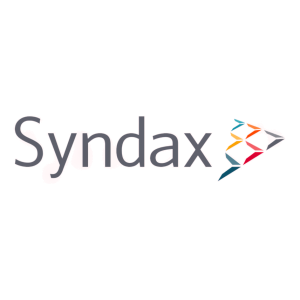Syndax Announces Publication of Pivotal Revumenib Data in Relapsed or Refractory mNPM1 Acute Myeloid Leukemia in the Journal Blood
Rhea-AI Summary
Syndax Pharmaceuticals (NASDAQ: SNDX) announced the publication of pivotal Phase 2 data for revumenib in the journal Blood, showing promising results in treating relapsed or refractory mutant NPM1 (mNPM1) acute myeloid leukemia (AML). The study demonstrated a nearly 50% overall response rate in heavily pre-treated patients.
The company submitted a supplemental New Drug Application (sNDA) for revumenib in R/R mNPM1 AML in April 2025 under the FDA's Real-Time Oncology Review program. This follows revumenib's FDA approval as Revuforj® in November 2024 for treating R/R acute leukemia with KMT2A translocation in patients one year and older.
Positive
- Nearly 50% overall response rate in heavily pre-treated R/R mNPM1 AML patients
- Revumenib was generally well-tolerated by patients
- sNDA submission completed under FDA's expedited Real-Time Oncology Review program
- First positive pivotal dataset in patients with NPM1 mutation, the most common genetic alteration in AML
Negative
- None.
News Market Reaction 1 Alert
On the day this news was published, SNDX gained 10.21%, reflecting a significant positive market reaction.
Data tracked by StockTitan Argus on the day of publication.
– Primary endpoint met in R/R mNPM1 AML patients in pivotal Phase 2 portion of the AUGMENT-101 trial –
– Robust remission rates in heavily pre-treated R/R mNPM1 AML population with nearly
– sNDA for revumenib in R/R mNPM1 AML submitted in April 2025 –
NEW YORK, May 07, 2025 (GLOBE NEWSWIRE) -- Syndax Pharmaceuticals (Nasdaq: SNDX), a commercial-stage biopharmaceutical company advancing innovative cancer therapies, today announced that data from the pivotal Phase 2 portion of the AUGMENT-101 trial of revumenib, a first-in-class menin inhibitor, in patients with relapsed or refractory (R/R) mutant NPM1 (mNPM1) acute myeloid leukemia (AML) have been published in Blood.
“We are thrilled to publish the first positive pivotal dataset in patients with an NPM1 mutation, the most common genetic alteration observed in AML,” said Neil Gallagher, M.D., Ph.D., President, Head of Research and Development at Syndax. “These important data support the safety and efficacy of revumenib in relapsed or refractory mNPM1 AML and serve as the foundation for the sNDA we submitted to the FDA under its RTOR program.”
“These are impressive, landmark results which underscore the potential for revumenib to meaningfully advance the standard of care for patients with R/R mNPM1 AML, a difficult to treat disease with a poor prognosis,” said Martha L. Arellano, M.D., Professor of Hematology and Oncology, Winship Cancer Institute of Emory University, and Principal Investigator in the AUGMENT-101 trial. “In the older, heavily pretreated population enrolled in this trial, it is very encouraging to observe that nearly
In November 2024, revumenib was FDA approved as Revuforj® for the treatment of R/R acute leukemia with a KMT2A translocation in adult and pediatric patients one year and older. In April 2025, Syndax completed the submission of a supplemental New Drug Application (sNDA) for revumenib in R/R mNPM1 AML under the FDA’s Real-Time Oncology Review (RTOR) program. The sNDA is supported by the positive pivotal data reported from the Phase 2 portion of the AUGMENT-101 trial.
About the published data
The publication entitled “Menin inhibition with revumenib for NPM1-mutated (NPM1m) relapsed or refractory acute myeloid leukemia: AUGMENT-101” reports results from patients with R/R mNPM1 AML who received revumenib in the pivotal Phase 2 portion of the AUGMENT-101 trial.
The protocol-defined efficacy-evaluable population for the primary analysis included the first 64 adult patients with R/R mNPM1 AML. In this efficacy population, the median age was 65 (range: 19, 84). Patients were heavily pretreated with
The study met the primary efficacy endpoint with a complete remission (CR) plus CR with partial hematological recovery (CRh) rate of
The overall response rate (ORR)1 was
In this single-arm trial, the median overall survival (OS) observed was 4.0 months (
The safety population included 84 adult and pediatric patients with R/R mNPM1 AML. The safety profile observed with revumenib in this population was consistent with previously reported data. Treatment-emergent serious adverse events that occurred in ≥
About Mutant NPM1 (mNPM1) Acute Myeloid Leukemia (AML)
Mutations in the NPM1 gene are the most common genetic alteration in adult AML and are observed in approximately
About Revuforj® (revumenib)
Revuforj (revumenib) is an oral, first-in-class, selective menin inhibitor that is FDA approved for the treatment of relapsed or refractory (R/R) acute leukemia with a lysine methyltransferase 2A gene (KMT2A) translocation in adult and pediatric patients one year and older.
Revumenib is in development for the treatment of R/R acute myeloid leukemia (AML) with a nucleophosmin 1 mutation (mNPM1). Positive pivotal data from the AUGMENT-101 trial in this population with revumenib as a monotherapy were recently reported and the Company submitted a supplemental NDA for revumenib in R/R mNPM1 AML in April 2025. Additionally, multiple trials of revumenib in combination with standard-of-care agents in mNPM1 AML or KMT2A-rearranged acute leukemia are ongoing or planned across the treatment landscape, including in newly diagnosed patients.
Revumenib was previously granted Orphan Drug Designation for the treatment of AML, ALL and acute leukemias of ambiguous lineage (ALAL) by the U.S. FDA and for the treatment of AML by the European Commission. The U.S. FDA also granted Fast Track designation to revumenib for the treatment of adult and pediatric patients with R/R acute leukemias harboring a KMT2A rearrangement or NPM1 mutation and Breakthrough Therapy Designation for the treatment of adult and pediatric patients with R/R acute leukemia harboring a KMT2A rearrangement.
IMPORTANT SAFETY INFORMATION
WARNING: DIFFERENTIATION SYNDROME
Differentiation syndrome, which can be fatal, has occurred with Revuforj. Signs and symptoms may include fever, dyspnea, hypoxia, pulmonary infiltrates, pleural or pericardial effusions, rapid weight gain or peripheral edema, hypotension, and renal dysfunction. If differentiation syndrome is suspected, immediately initiate corticosteroid therapy and hemodynamic monitoring until symptom resolution.
WARNINGS AND PRECAUTIONS
Differentiation syndrome: Revuforj can cause fatal or life-threatening differentiation syndrome (DS). Symptoms of DS, including those seen in patients treated with Revuforj, include fever, dyspnea, hypoxia, peripheral edema, pleuropericardial effusion, acute renal failure, and/or hypotension. In clinical trials, DS occurred in 39 (
Reduce the white blood cell count to less than 25 Gi/L prior to starting Revuforj. If DS is suspected, immediately initiate treatment with systemic corticosteroids (e.g., dexamethasone 10-mg IV every 12 hours in adults or dexamethasone 0.25-mg/kg/dose IV every 12 hours in pediatric patients weighing less than 40 kg) for a minimum of 3 days and until resolution of signs and symptoms. Institute supportive measures and hemodynamic monitoring until improvement. Interrupt Revuforj if severe signs and/or symptoms persist for more than 48 hours after initiation of systemic corticosteroids, or earlier if life-threatening symptoms occur such as pulmonary symptoms requiring ventilator support. Restart steroids promptly if DS recurs after tapering corticosteroids.
QTc interval prolongation: In the clinical trials, QTc interval prolongation was reported as an adverse reaction in 39 (
Correct electrolyte abnormalities, including hypokalemia and hypomagnesemia, prior to treatment with Revuforj. Perform an electrocardiogram (ECG) prior to initiation of Revuforj, and do not initiate Revuforj in patients with QTcF >450 msec. Perform an ECG at least once weekly for the first 4 weeks and at least monthly thereafter. In patients with congenital long QTc syndrome, congestive heart failure, electrolyte abnormalities, or those who are taking medications known to prolong the QTc interval, more frequent ECG monitoring may be necessary. Concomitant use with drugs known to prolong the QTc interval may increase the risk of QTc interval prolongation.
- Interrupt Revuforj if QTcF increases >480 msec and <500 msec, and restart Revuforj at the same dose twice daily after the QTcF interval returns to ≤480 msec
- Interrupt Revuforj if QTcF increases >500 msec or by >60 msec from baseline, and restart Revuforj twice daily at the lower-dose level after the QTcF interval returns to ≤480 msec
- Permanently discontinue Revuforj in patients with ventricular arrhythmias and in those who develop QTc interval prolongation with signs or symptoms of life-threatening arrhythmia.
Embryo-fetal toxicity: Revuforj can cause fetal harm when administered to a pregnant woman. Advise pregnant women of the potential risk to a fetus. Advise females of reproductive potential and males with female partners of reproductive potential to use effective contraception during treatment with Revuforj and for 4 months after the last dose of Revuforj.
ADVERSE REACTIONS
Fatal adverse reactions occurred in 4 (
Serious adverse reactions were reported in 99 (
The most common adverse reactions (≥
DRUG INTERACTIONS
Drug interactions can occur when Revuforj is concomitantly used with:
- Strong CYP3A4 inhibitors: reduce Revuforj dose
- Strong or moderate CYP3A4 inducers: avoid concomitant use with Revuforj
- QTc-prolonging drugs: avoid concomitant use with Revuforj. If concomitant use is unavoidable, obtain ECGs when initiating, during concomitant use, and as clinically indicated. Withhold Revuforj if the QTc interval is >480 msec. Restart Revuforj after the QTc interval returns to ≤480 msec.
SPECIFIC POPULATIONS
Lactation: advise lactating women not to breastfeed during treatment with Revuforj and for 1 week after the last dose.
Pregnancy and testing: Revuforj can cause fetal harm when administered to a pregnant woman. Verify pregnancy status in females of reproductive potential within 7 days prior to initiating Revuforj.
Pediatric: monitor bone growth and development in pediatric patients.
Geriatric: compared to younger patients, the incidences of QTc prolongation and edema were higher in patients 65 years and older.
Infertility: based on findings in animals, Revuforj may impair fertility. The effects on fertility were reversible.
To report SUSPECTED ADVERSE REACTIONS, contact Syndax Pharmaceuticals at 1-888-539-3REV or FDA at 1-800-FDA-1088 or www.fda.gov/medwatch.
Please see Full Prescribing Information, including BOXED WARNING.
About Syndax
Syndax Pharmaceuticals is a commercial-stage biopharmaceutical company advancing innovative cancer therapies. Highlights of the Company's pipeline include Revuforj® (revumenib), an FDA-approved menin inhibitor, and Niktimvo™ (axatilimab-csfr), an FDA-approved monoclonal antibody that blocks the colony stimulating factor 1 (CSF-1) receptor. Fueled by our commitment to reimagining cancer care, Syndax is working to unlock the full potential of its pipeline and is conducting several clinical trials across the continuum of treatment. For more information, please visit www.syndax.com/ or follow the Company on X and LinkedIn.
Forward-Looking Statements
This press release contains forward-looking statements within the meaning of the Private Securities Litigation Reform Act of 1995. Words such as "anticipate," "believe," "could," "estimate," "expects," "intend," "may," "plan," "potential," "predict," "project," "should," "will," "would" or the negative or plural of those terms, and similar expressions (as well as other words or expressions referencing future events, conditions or circumstances) are intended to identify forward-looking statements. These forward-looking statements are based on Syndax's expectations and assumptions as of the date of this press release. Each of these forward-looking statements involves risks and uncertainties. Actual results may differ materially from these forward-looking statements. Forward-looking statements contained in this press release include, but are not limited to, statements about the progress, timing, clinical development and scope of clinical trials, the reporting of clinical data for Syndax's product candidates, the acceptance of Syndax and its partners' products in the marketplace, sales, marketing, manufacturing and distribution requirements, and the potential use of its product candidates to treat various cancer indications and fibrotic diseases. Many factors may cause differences between current expectations and actual results, including: unexpected safety or efficacy data observed during preclinical or clinical trials; clinical trial site activation or enrollment rates that are lower than expected; changes to Revuforj's or Niktimvo’s commercial availability; changes in expected or existing competition; changes in the regulatory environment; failure of Syndax's collaborators to support or advance collaborations or product candidates; and unexpected litigation or other disputes. Other factors that may cause Syndax's actual results to differ from those expressed or implied in the forward-looking statements in this press release are discussed in Syndax's filings with the U.S. Securities and Exchange Commission, including the "Risk Factors" sections contained therein. Except as required by law, Syndax assumes no obligation to update any forward-looking statements contained herein to reflect any change in expectations, even as new information becomes available.
All other trademarks are the property of their respective owners.
References
1. Overall response rate (ORR) includes CR, CRh, CRp, CRi, MLFS, and PR; Composite complete remission (CRc) includes CR, CRh, CRp, and CRi.
CR = Complete remission
CRh = Complete remission with partial hematologic recovery
CRp = Complete remission with incomplete platelet recovery
CRi = Complete remission with incomplete count recovery
MLFS = Morphologic leukemia-free state
PR = Partial response
Syndax Contact
Sharon Klahre
Syndax Pharmaceuticals, Inc.
sklahre@syndax.com
Tel 781.684.9827
SNDX-G








